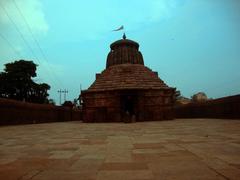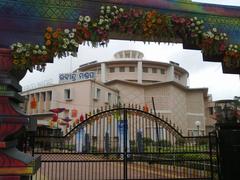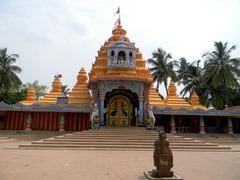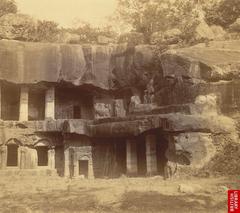
Comprehensive Guide to Visiting Bhubaneswar, Khordha District, India
Date: 13/08/2024
Captivating Introduction
Welcome to Bhubaneswar, the Temple City of India, where history, spirituality, and modernity blend seamlessly into a vibrant tapestry of culture and tradition. Imagine walking through a city where every stone tells a story, where the air hums with ancient chants, and where the very ground you tread once flowed with the blood of a transformative war. Bhubaneswar, the capital city of Odisha, is a living, breathing museum of ancient India, often referred to as the ‘City of Temples’ due to its staggering array of over 700 temples that date back to various centuries. From the imposing Lingaraja Temple, an 11th-century marvel dedicated to Lord Shiva, to the serene Dhauli Shanti Stupa, a beacon of peace symbolizing Emperor Ashoka’s transformation after the Kalinga War, Bhubaneswar offers an unparalleled journey through time (Culture and Heritage).
But Bhubaneswar is more than just its ancient roots. It’s a city that pulses with life, where vibrant festivals like Rath Yatra and Durga Puja bring the streets alive with colors, music, and fervor. The local cuisine, a delightful blend of traditional Odia flavors, offers a sensory feast with dishes like Dalma and Pakhala, as well as sweets like Chhena Poda and Rasagola (RedBus Blog).
For the intrepid traveler, Bhubaneswar holds hidden gems and local secrets waiting to be discovered. Whether it’s finding the best chai in a quaint café or stumbling upon a local festival unknown to tourists, the city promises an adventure at every turn. With its well-connected transport system, including the Biju Patnaik International Airport, getting to Bhubaneswar is convenient and hassle-free (True Yatra).
So, pack your bags and get ready to explore Bhubaneswar with Audiala, your ultimate travel guide app. Audiala offers beautifully crafted, concise yet deep audio guides that bring the sights and sounds of this incredible city to life. Download Audiala before your visit to unlock Bhubaneswar’s secrets and stories, and embark on a journey like no other.
Table of Contents
- Historical Significance
- Key Attractions
Historical Significance of Bhubaneswar, Khordha District, India
A Journey Through Time
Imagine walking through a city where every stone tells a story, where the air hums with ancient chants, and where the very ground you tread once flowed with the blood of a transformative war. Welcome to Bhubaneswar, the Temple City of India.
Ancient Origins and Early History
Bhubaneswar, the capital city of Odisha, is often referred to as the “Temple City of India” due to its rich history and an abundance of ancient temples. The city’s historical significance dates back to the 3rd century BCE, with its roots deeply intertwined with the Kalinga War and the subsequent transformation of Emperor Ashoka. The city flourished as a center of Hindu worship from the 7th century CE, with the construction of numerous sandstone temples around the sacred Bindusagar Lake (World History).
The Kalinga War and Ashoka’s Transformation
One of the most pivotal events in Bhubaneswar’s history is the Kalinga War, fought in 261 BCE. The war, which took place near the Daya River, was marked by immense bloodshed and loss of life. The sight of the river turning red with the blood of the slain profoundly impacted Emperor Ashoka, leading to his conversion to Buddhism and his subsequent efforts to spread the message of peace and non-violence (Culture and Heritage).
Architectural Marvels and Temple Construction
The period between the 7th and 12th centuries CE saw a significant surge in temple construction in Bhubaneswar. The city was once home to approximately 2000 temples, of which around 700 still exist today. These temples are primarily dedicated to Lord Shiva, but the city also houses structures related to Buddhism and Jainism (Discover Bhubaneswar).
Lingaraja Temple
The Lingaraja Temple, dating back to the 11th century, is one of the largest and most revered temples in Bhubaneswar. Dedicated to Lord Shiva, this temple is a prime example of the Kalinga architectural style, featuring intricate carvings, towering spires, and sacred sanctums. The temple’s natmandir, bhog mandapa, and vimana are particularly noteworthy for their architectural brilliance (Outlook Traveller).
Mukteshvara Temple
Another significant temple is the Mukteshvara Temple, known for its exquisite craftsmanship and spiritual sanctity. Built in the 10th century, this temple is a masterpiece of Kalinga architecture, featuring a torana (arched gateway) that is considered one of the finest in India. The temple’s serene ambiance and lush surroundings make it a must-visit for those interested in ancient architecture and spirituality (Outlook Traveller).
Parashurameshwar Temple
The Parashurameshwar Temple, constructed in the 7th century, is another gem of Kalinga architecture. Dedicated to Lord Shiva, this temple is renowned for its intricate carvings depicting various Hindu deities and mythical creatures. The temple’s historical and cultural significance makes it a vital pilgrimage site and a treasure trove for history enthusiasts (Outlook Traveller).
Ananta Vasudeva Temple
The Ananta Vasudeva Temple, built in the 13th century, is dedicated to Lord Krishna. This temple stands out for its architectural grandeur and religious significance. It is one of the few temples in Bhubaneswar dedicated to Lord Krishna, making it a unique and important site for devotees and historians alike (Outlook Traveller).
Rajarani Temple
The Rajarani Temple, also known as the “Temple of Love,” dates back to the 11th century. This temple is famous for its sculptures and the use of a unique variety of sandstone, giving it a distinctive appearance. The temple’s well-maintained gardens and serene environment add to its charm, making it a popular destination for tourists and history buffs (Discover Bhubaneswar).
Dhauli Shanti Stupa
The Dhauli Shanti Stupa, also known as the Peace Pagoda, is a significant landmark located on the Dhauli hill, just a few kilometers south of Bhubaneswar. This edifice symbolizes peace and commemorates Emperor Ashoka’s transformation after the Kalinga War. The stupa is a major pilgrimage site for Buddhists and a significant attraction for history enthusiasts. Adjacent to the stupa are the Edicts of Ashoka, inscribed in the Brahmi script, which highlight the moral and ethical guidelines laid down by Ashoka (Culture and Heritage).
Ekamra Kshetra
Ekamra Kshetra, or the temple city of Bhubaneswar, is a series of ancient sandstone temples, heritage ponds, and water tanks. This area is a testament to an ancient continuous architectural and historical heritage spanning over 2000 years, from the 3rd century BCE to the 15th century CE. The Government of Odisha has initiated the Ekamra Kshetra development project to modernize the area and attract more tourists (Wikipedia).
Cultural and Religious Significance
Bhubaneswar’s historical significance is not limited to its architectural marvels. The city is also a vibrant center of cultural and religious activities. Festivals such as Ganesh Chaturthi, Durga Puja, and Laxmi Puja are celebrated with great enthusiasm. The annual Kalinga Mahotsav, held at the Dhauli Shanti Stupa, celebrates the art of martial dance and promotes peace over war, symbolically held at the location that once witnessed the horrors of conflict (True Yatra).
Local Secrets and Hidden Gems
For those planning to visit Bhubaneswar, the best time to explore the city is during the winter season (October to February), when the weather is cool and comfortable. While you’re here, don’t miss out on discovering hidden gems like a quaint café that serves the best chai or a local festival unknown to tourists. The city is well-connected by air, with the Biju Patnaik International Airport being the nearest airport. Visitors can also explore the local markets and savor the famous local cuisine, including dishes like Machha Jholo, Gupchup, and Dalma (True Yatra).
Sensory Descriptions
As you wander through Bhubaneswar, let your senses guide you. Smell the incense wafting through the temples, taste the vibrant flavors of local delicacies, hear the resonant temple bells, touch the ancient stone carvings, and see the vivid colors of local attire. The city is a feast for the senses, promising an immersive experience.
Interactive Elements
Embark on a sensory exploration of Bhubaneswar. Capture the hidden carvings at Mukteshwar Temple and share a picture with the hashtag #BhubaneswarSecrets. Find the best chai in a quaint café or participate in a local festival unknown to tourists.
Key Attractions
Lingaraj Temple: The Crown Jewel
Step into the ancient world of the Lingaraj Temple, a masterpiece of Kalinga architecture dedicated to Lord Shiva. This 11th-century marvel, with its 180-feet tall Vimana, is a labyrinth of intricate carvings and spiritual energy. Wander through its extensive 250,000 square-foot complex dotted with over 50 smaller shrines. Feel the history under your feet as you explore this iconic symbol of Bhubaneswar (Wikipedia).
Udayagiri and Khandagiri Caves: Time-Travel to the 1st Century BCE
Just 6 kilometers from Bhubaneswar, these ancient Jain rock-cut caves offer a peek into a bygone era. Marvel at the finely carved sculptures and inscriptions, including the famous Hathigumpha inscription by King Kharavela. Climb up to these historic caves for stunning panoramic views and a sense of the ascetic life of Jain monks (Wikipedia).
Dhauli Shanti Stupa: A Beacon of Peace
About 8 kilometers from Bhubaneswar, the white pagoda of Dhauli Shanti Stupa stands as a symbol of peace and non-violence. Built in the 1970s by the Japan Buddha Sangha and Kalinga Nippon Buddha Sangha, this serene site marks the battlefield of the Kalinga War that led Emperor Ashoka to embrace Buddhism. Enjoy the tranquil surroundings and the scenic view of the Daya River (Holiday Landmark).
Nandankanan Zoological Park: A Wilderness Adventure
Located in the lush Chandaka Forest, about 15 kilometers from Bhubaneswar, Nandankanan Zoological Park is a haven for wildlife lovers. Established in 1960, this zoo houses over 1,200 animals, including the rare white tiger and the Indian pangolin. Explore its botanical garden, reptile park, and safari park for a fun family outing (Travel Setu).
Rajarani Temple: The Love Temple
An architectural gem from the 11th century, Rajarani Temple is renowned for its unique reddish-gold sandstone and erotic carvings. Unlike other temples in Bhubaneswar, it is not dedicated to any deity, earning it the nickname ‘love temple’. Stroll through its serene gardens and admire the intricate artistry (Wikipedia).
Odisha State Museum: A Cultural Treasure Trove
Delve into the rich cultural heritage of Odisha at the Odisha State Museum. Located in the heart of Bhubaneswar, this museum boasts an extensive collection of archaeological artifacts, traditional weapons, rare manuscripts, and indigenous art. Established in 1932, it’s an educational journey through Odisha’s history and culture (Travel Setu).
Ekamra Kanan Botanical Gardens: A Green Retreat
Escape the city’s hustle at Ekamra Kanan Botanical Gardens, a sprawling oasis perfect for leisurely walks and picnics. Explore the cactus house, orchid house, and large lake. Open year-round with a nominal entry fee, it’s a favorite among locals and tourists alike (Holiday Landmark).
Pathani Samanta Planetarium: A Cosmic Journey
Named after the famed Indian astronomer, Pathani Samanta Planetarium is a must-visit for star-gazers. Located in Acharya Vihar, it offers educational shows about the universe, including the solar system, black holes, and exoplanets. A fantastic destination for families and space enthusiasts, it operates year-round (Wanderon).
ISKCON Temple: A Spiritual Oasis
Find tranquility at the ISKCON Temple, a serene sanctuary for devotees of Lord Krishna. Near NH16, this temple is known for its beautiful architecture and peaceful environment. Participate in prayers, enjoy vegetarian meals, and admire the temple’s architectural beauty. Open from 4 am to 8:30 pm, entry is free (Wanderon).
Chilika Lake: A Birdwatcher’s Paradise
A short drive from Bhubaneswar, Chilika Lake is the largest coastal lagoon in India and the second largest in the world. This biodiversity hotspot is home to numerous species of birds, fish, and wildlife. Famous for its migratory birds like flamingos and pelicans, boat tours are available to explore its beauty (Wanderon).
Regional Tribal Museum: A Cultural Journey
Discover the diverse tribal cultures of Odisha at the Regional Tribal Museum. Featuring life-size replicas of traditional huts from communities like the Kandha, Santal, and Dongria Kondh, it offers a fascinating glimpse into tribal life. Open from 10 am to 5:30 pm, entry is Rs. 50, closed on Mondays (Wanderon).
Barabati Stadium: The Sports Hub
In nearby Cuttack, Barabati Stadium is a key venue for cricket and sports events. Hosting national and international matches, it’s a hotspot for sports enthusiasts. Open from 10:00 am to 6:00 pm, entry is free (Wanderon).
Visitor Tips
- Best Time to Visit: Visit Bhubaneswar from October to February when the weather is pleasant, with temperatures ranging from 7°C to 28°C. Avoid the scorching summers and heavy monsoon rains (Audiala).
- How to Get There: Bhubaneswar is well-connected by air via Biju Patnaik International Airport, and by rail and road, making it easily accessible from various parts of India (Audiala).
- Local Transport: Convenient options include auto-rickshaws, taxis, and app-based services like Ola and Uber. Public buses by OSRTC are budget-friendly alternatives (Holidify).
Embark on your Bhubaneswar adventure with Audiala, your ultimate travel guide, offering insights, itineraries, and more to make your journey unforgettable.
Cultural Insights: Comprehensive Guide to Visiting Bhubaneswar, Khordha District, India
Welcome to Bhubaneswar: The City of Temples
Welcome to Bhubaneswar, the City of Temples with over 700 ancient sanctuaries that whisper tales of devotion and artistry. Imagine strolling through a city where every corner hides a piece of history… and a delicious street food stall!
Historical Significance: A Temple Treasure Hunt
Bhubaneswar, the capital city of Odisha, is often referred to as the ‘City of Temples’ due to its rich historical and cultural heritage. The city is home to over 700 ancient temples, each narrating tales of devotion, artistry, and spirituality. The Lingaraj Temple, dedicated to Lord Shiva, stands as the crowning jewel of Bhubaneswar’s temple architecture. With its imposing height and exquisite carvings, it is a sight to behold for worshippers and tourists alike (Culture and Heritage).
Challenge: Find the hidden carvings at Mukteshwar Temple and share a picture with the hashtag #BhubaneswarSecrets. The Mukteshwar Temple captivates visitors with its delicate sculptures and elaborate archways, offering a glimpse into the artistic prowess of ancient Odisha. These temples are not just architectural marvels but also serve as sacred sanctuaries where devotees seek solace and spiritual enlightenment (Culture and Heritage).
Festivals and Celebrations: The Heartbeat of Bhubaneswar
Bhubaneswar and the Khordha district are vibrant with festivals that reflect the region’s rich cultural tapestry. One of the most significant festivals is the Rath Yatra, celebrated with great fervor and devotion. This festival involves the procession of deities on chariots and attracts thousands of devotees from across the country. Another notable festival is Durga Puja, where elaborate pandals (temporary structures) are set up, and the city comes alive with lights, music, and cultural performances (Odisha Guide).
Pro Tip: When visiting temples, remember to remove your shoes and don’t be surprised if someone offers you prasad—it’s a sweet blessing! The Ekamra Utsav is a cultural festival that showcases the traditional dance, music, and crafts of Odisha. It provides a platform for local artisans and performers to display their talents and keeps the cultural heritage of the region alive (Odisha Guide).
Local Art and Crafts: A Canvas of Creativity
The Khordha district is renowned for its rich tradition of handloom and handicrafts. The region is famous for its intricate applique work, known as Pipli, which involves creating beautiful patterns using colorful fabrics. These appliques are used to make various items such as wall hangings, lampshades, and umbrellas (Odisha Tour).
Another significant craft is the silver filigree work, locally known as Tarakasi. This delicate art form involves creating intricate designs using thin silver wires and is used to make jewelry, decorative items, and utensils. The artisans of Khordha are also skilled in stone carving, a tradition that dates back to ancient times and is evident in the exquisite sculptures found in the temples of Bhubaneswar (Odisha Tour).
Culinary Delights: A Feast for the Senses
The culinary landscape of Bhubaneswar and Khordha is a delightful blend of traditional Odia cuisine and modern flavors. One must-try dish is the Dalma, a wholesome preparation made with lentils and vegetables, seasoned with traditional spices. Another popular dish is Pakhala, fermented rice served with water, curd, and fried or mashed vegetables, which is particularly refreshing during the hot summer months (RedBus Blog).
For those with a sweet tooth, the region offers a variety of delectable sweets such as Chhena Poda, a baked cheese dessert, and Rasagola, soft cheese balls soaked in sugar syrup. Street food enthusiasts can indulge in local favorites like Dahi Bara Aloo Dum, a combination of lentil dumplings soaked in yogurt and spicy potato curry (RedBus Blog).
Visitor Tips: Plan Like a Pro
When visiting Bhubaneswar and the Khordha district, it is essential to plan your trip around the weather. The best time to visit is during the winter months, from October to February, when the weather is pleasant and conducive for sightseeing. Summers can be extremely hot, and the monsoon season, from June to September, brings heavy rainfall, which might hinder travel plans (Odisha Guide). Think summers in Bhubaneswar are hot? They’re like being in a sauna with a spicy curry!
For accommodation, the region offers a range of options to suit every budget and preference. From luxury resorts and hotels to budget-friendly guesthouses and homestays, visitors can find a comfortable stay that caters to their needs. Bhubaneswar, being the capital city, provides a wide range of accommodation choices for those exploring the Khordha district (Odisha Guide).
Modern Attractions: A Blend of Old and New
While Bhubaneswar is steeped in history, it also boasts modern attractions that cater to diverse interests. The Nandankanan Zoological Park, located about 20 kilometers from the city, is a famous zoo and botanical garden. Spread over 400 hectares, the zoo is home to a wide variety of animals, including tigers, lions, elephants, reptiles, and numerous bird species. Nandankanan is renowned for its white tiger safari and the conservation of endangered species (RedBus Blog).
The Ekamra Kanan Botanical Gardens, also known as Cactus Garden, is a beautiful park in the heart of Bhubaneswar. The gardens feature various plants, including many cacti and succulents. The park’s well-maintained lawns, colorful flower beds, and serene environment make it a popular spot for picnics, leisurely walks, and nature photography (RedBus Blog).
Spiritual Odyssey: A Journey Within
Beyond their architectural splendor, the temples of Bhubaneswar serve as sacred sanctuaries where devotees seek solace and spiritual enlightenment. The air is heavy with the scent of incense, and the rhythmic chants of prayers reverberate through the halls, creating an atmosphere of tranquility and reverence. Devotees from far and wide flock to these sacred sites to pay homage to their deities and partake in age-old rituals and ceremonies (Culture and Heritage).
Whether it’s offering prayers at the Rajarani Temple or seeking blessings at the Ananta Vasudeva Temple, every visit is imbued with a sense of divine connection and spiritual renewal. These temples stand as guardians of our cultural heritage, reminding us of our roots and the traditions that bind us together as a society (Culture and Heritage).
Shopping and Local Markets: A Shopper’s Paradise
The urban areas of Bhubaneswar and Khordha Town offer a vibrant city life experience. Shopping enthusiasts can explore bustling markets like Ekamra Haat and the local bazaars to purchase handicrafts, textiles, and traditional artifacts. The city also boasts modern shopping malls, multiplexes, and entertainment centers for those seeking a contemporary experience (Odisha Guide).
Ekamra Haat is a popular market where visitors can find a variety of handcrafted items, including textiles, pottery, and jewelry. The market is also known for its food stalls, offering a taste of local cuisine. For a more modern shopping experience, visitors can head to the city’s malls, which house a range of national and international brands (Odisha Guide).
Natural Wonders: Serenity Awaits
The Khordha district is blessed with scenic landscapes and natural beauty. The serene Nandan Kanan Botanical Garden and the captivating Barunei Hill are ideal spots for nature lovers. The Tapang Green Lake, located at Nijigarh in Khordha District, is an artificial lake created after the mining of stone mines. The reflection of the sun’s rays on the green waters of Lake Tapang is wonderful, making it a popular destination for both state and foreign tourists (Odisha Tour).
Barunei Hill is not only a natural wonder but also a place of historical significance. The ruins of the ancient fort can now be seen at the foot of Barunei, in addition to being an important center of the Khordha handloom industry. The hill is also home to the Maa Barunei temple, a Shaktipitha in Odisha, making it a popular pilgrimage and picnic spot (Odisha Tour).
By exploring these cultural insights, visitors can gain a deeper understanding and appreciation of Bhubaneswar and the Khordha district, making their journey a truly memorable experience. Use Audiala to enhance your exploration with beautifully crafted, concise, yet deep audio guides that bring the sights and sounds of this incredible city to life.
Call to Action
As your journey through Bhubaneswar, the Temple City of India, comes to an end, it’s hard not to be captivated by the rich tapestry of history, spirituality, and culture that defines this remarkable city. From the ancient temples that stand as silent witnesses to centuries of devotion and artistry to the bustling markets and vibrant festivals that bring the city to life, Bhubaneswar offers an experience that is both timeless and contemporary.
The architectural marvels of Lingaraja Temple, Mukteshvara Temple, and the Dhauli Shanti Stupa serve as reminders of the city’s glorious past, while modern attractions like the Nandankanan Zoological Park and Ekamra Kanan Botanical Gardens provide a refreshing contrast. The culinary delights, from traditional Odia dishes to delectable sweets, offer a feast for the senses, making every meal an adventure in itself (Culture and Heritage).
But what truly sets Bhubaneswar apart are the local secrets and hidden gems that await the curious traveler. Whether it’s discovering the intricate applique work of Pipli, marveling at the silver filigree craftsmanship, or simply soaking in the serene ambiance of a lesser-known temple, Bhubaneswar invites you to look beyond the obvious and uncover its many layers (Odisha Tour).
As you reflect on your visit, remember that Bhubaneswar is a city that thrives on its ability to surprise and enchant. It’s a place where the past and present coexist harmoniously, offering a unique blend of experiences that cater to every interest and curiosity. So, whether you’re a history buff, a spiritual seeker, a foodie, or an adventurer, Bhubaneswar has something special in store for you.
And as you plan your next visit, let Audiala be your trusted companion. With its expertly crafted audio guides, Audiala enhances your exploration, providing deeper insights and uncovering hidden gems that make your journey truly unforgettable. Download Audiala today and let it be your gateway to the many secrets and stories of Bhubaneswar.
References
- Culture and Heritage, 2024
- RedBus Blog, 2024
- True Yatra, 2024
- Odisha Tour, 2024









